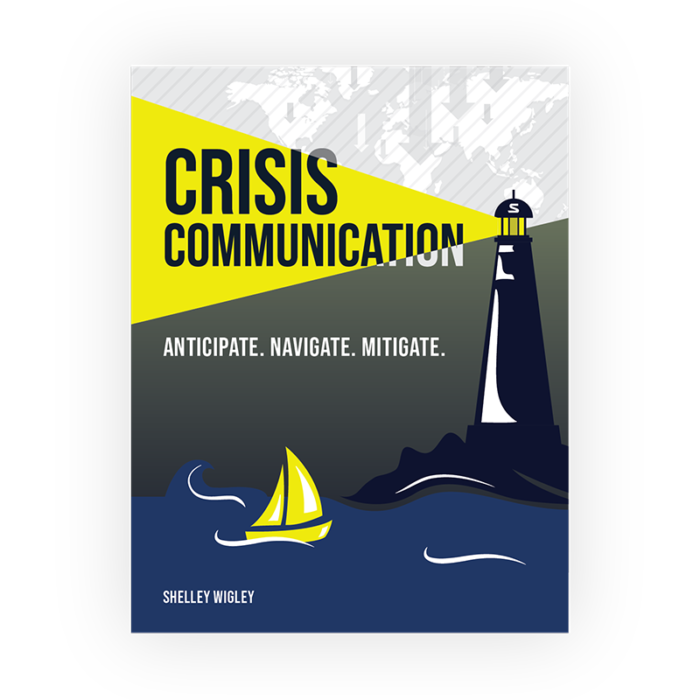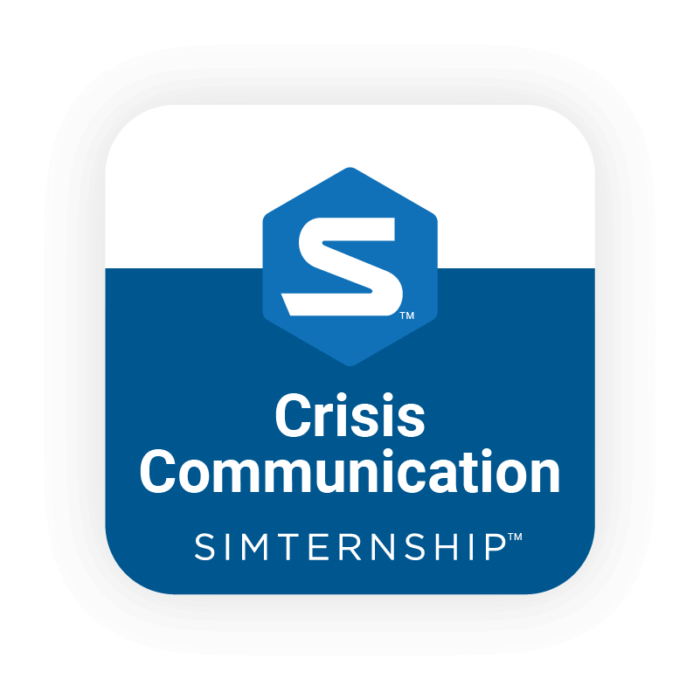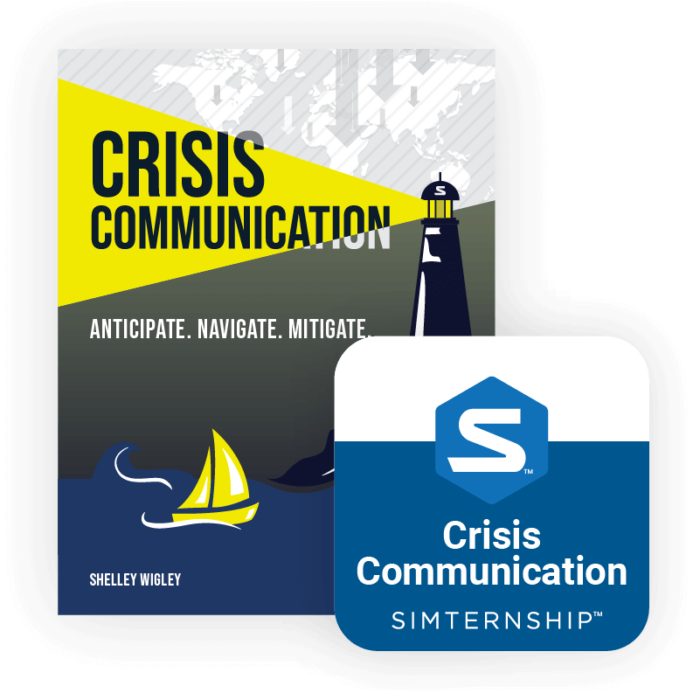No individual or organization is immune to a crisis — it can happen anytime, anywhere, and to anyone. It’s not if students face a crisis in their future business, PR, or marketing careers, but when. To thrive, students need to learn powerful strategies for turning crises into organizational opportunities.
In Stukent’s courseware, “Crisis Communication: Anticipate. Navigate. Mitigate,” author Shelley Wigley writes: “A crisis threatens the reputation and/or existence of an organization. … [And crisis communication is] the words and actions used to manage information during a crisis. … The goal of crisis communication is to protect both organizations and individuals from harm.”
This courseware gives students a solid foundation in handling crises, resolving risks, developing communication plans, managing the media, and so much more. Students will hone their critical thinking skills, develop effective communication styles, and prepare to navigate the waters of any crisis!
The Crisis Life Cycle
Every crisis has a beginning, middle, and end. According to Wigley, the three phases of a crisis include:
The Anticipation Phase: “The Anticipation Phase of the crisis life cycle is similar to what Coombs (2019) refers to as the pre-crisis stage, which involves three substages: 1) signal detection, 2) prevention, and 3) crisis preparation,” says Wigley. In this courseware, Wigley offers an additional substage of the Anticipation Phase: “4) pre-crisis communication, which includes communication strategies that can help protect stakeholders’ attitudes in the event of a crisis.”
The Navigation Phase: “The Navigation Phase occurs when something triggers a crisis — a tweet, an event, a rumor, et cetera. The Navigation Phase is over once the crisis is resolved,” says Wigley. Organizations must navigate the crisis event with care to avoid intensifying the issues they face. The Navigation Phase often involves media relations, social media management, and managing stakeholder relationships.
The Mitigation Phase: “Actions taken during this final stage help to mitigate the crisis, or make the situation less severe or painful,” according to Wigley. These actions may include evaluating the organization’s crisis communication efforts, improving relations with stakeholders, and confirming the crisis is officially over.
To respond effectively to crises, students need to understand how crises evolve — particularly if it allows them to catch future issues in the Anticipation Phase. But if an event reaches the Navigation Phase, students can implement the following best practices to reduce the impact on their future organization.
The Five C’s of Crisis Communication
Crises may be unavoidable, but that doesn’t mean an organization has to suffer additional adverse effects. “The impact of a crisis on an organization can be devastating,” Wigley says. “A poorly handled crisis can ruin a company’s reputation, create negative attitudes among stakeholders, and decrease revenue.”
To avoid such disastrous repercussions, students can utilize five best practices: Composure, Context, Content, Channels, and Consequences.
1) Composure
When a crisis occurs, the first step is to stay calm and assess the situation. While people are biologically programmed with a fight, flight, or freeze response, a stress reaction can do more harm than good in a crisis event. Students can use case studies to practice being members of an organization’s crisis communications team, where they can step back and reflect on crises that other brands and businesses have faced.
Giving students experience with managing crises while in the classroom will equip them to remain calm, collected, and composed when they face crises in the real world.
2) Context
The type of crisis an organization faces will dictate its response. Students should analyze the circumstances of a crisis: is it an intentional crisis, or an act intended to harm a business, its employees, or its customers? Intentional crises may include poor risk management, sabotage, layoffs, and unethical leadership. Or is the organization facing an unintentional crisis, such as a natural disaster, pandemic, or downturn in the economy? Does the crisis impact the organization’s operations? Does it impact the organization’s reputation? Or both?
Time is of the essence, but not at the expense of accuracy. In a crisis, students need to know how to gather information, identify affected parties, and talk to colleagues with diverse backgrounds and perspectives. This process will help them develop a rich, complex understanding of a crisis event and craft an appropriate response plan.
3) Content
Once students have analyzed the situation, they need to decide how to respond. American business magnate and investor Warren Buffett has a popular saying: “One’s objective should be to get it right, get it fast, get it out, get it over. Your problem won’t improve with age.”
To handle a crisis efficiently, students should learn to craft complete, accurate, and transparent statements up front. Apologies should be immediate, and organizations should take responsibility for their mistakes. If the crisis is an intentional one, it’s important to express that it won’t happen again and take steps to ensure it doesn’t.
Bad news can’t be hidden, and “cover-ups only make a crisis continue,” says Wigley. Reporters will often expose anything an organization tries to hide, turning the cover-up into the main story and damaging organizational credibility. Additionally, saying “no comment” to the media is unhelpful and implies an organization has something to hide.
4) Channels
Not only do organizations need to decide what to say in a crisis, they also need to choose where to say it.
Students need to practice selecting the best channels to disseminate information to their stakeholders and the general public. With strong media relations training, students can deliver a message to their audiences from a trusted, reliable source. A concise, informative press release can communicate essential information — the who, what, when, where, and why of the crisis — to the media with precision. A spokesperson can add an empathetic, relatable touch to a live press conference. And with social media, organizations can keep their stakeholders updated and manage their brand’s reputation online.
To prepare, students can craft responses in the classroom for current organizational crises, such as social media posts, press releases, statements for spokespeople, and more.
5) Consequences
The bestselling author Maya Angelou once wrote: “People will forget what you said, people will forget what you did, but people will never forget how you made them feel.” Students learning how to manage crises should always consider how their messaging will be perceived by stakeholders — if they don’t, they stand to make a crisis worse.
Once the crisis has been addressed, an organization should monitor inbound and outbound communications, address stakeholder questions, and track how audiences are talking about the organization online. “A key component of effective crisis communications is understanding what various audiences and stakeholders are saying about an organization at any given time,” said George Sopko, vice president of Stanton, a communications agency. If an organization is paying attention to its audiences, it can address negative trends before they grow into issues.
The Best Tool for Teaching Crisis Communication
It’s certainly difficult to give students hands-on, real-world experience with crisis communication, which is why Stukent is building Stukent Crisis Communication Simternship™, an all-new simulation that pairs with Wigley’s “Crisis Communication” courseware. This robust simulation puts students into a high-pressure situation where they will practice responding to both reputational and operational crises without the real-world risk. Best of all, Stukent simulations are easy to implement in any curriculum and include powerful resources for both educators and students.



With Wigley’s “Crisis Communication” courseware and Stukent’s Crisis Communication Simternship™, educators can prepare students to handle every stage of any adverse situation that may come their way. Not only will students practice keeping calm under pressure, they’ll also have the chance to define the crisis context, develop content, select channels, and monitor the consequences of their crisis communication … helping them prepare to turn future crises into powerful organizational opportunities.
To get a first look at Shelley Wigley’s innovative “Crisis Communication” courseware or its complementary simulation, Stukent Crisis Communication Simternship™, use your complimentary access.






